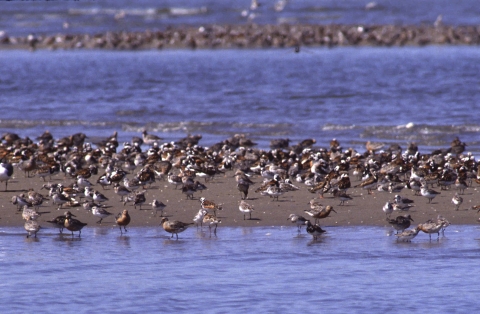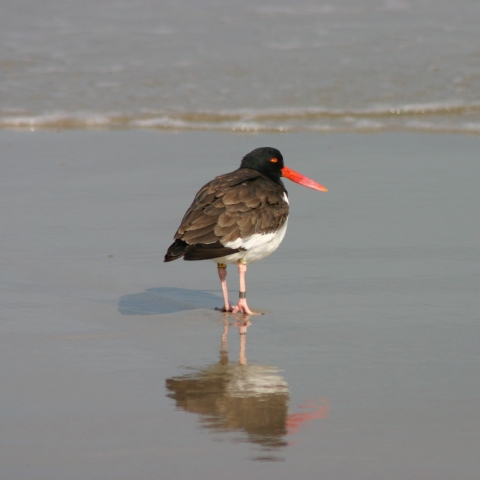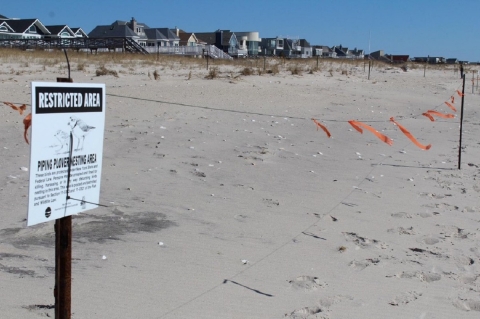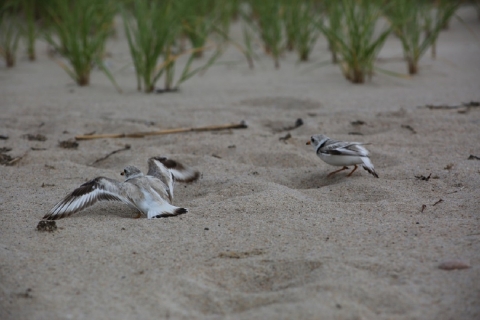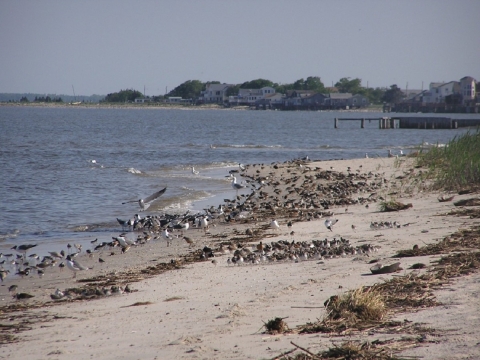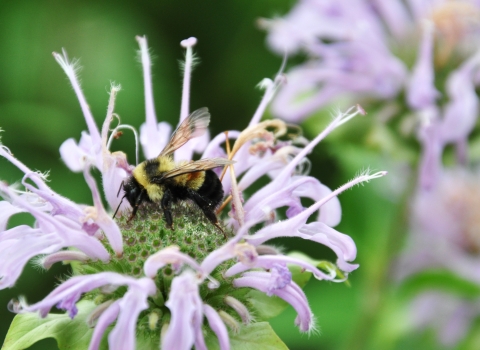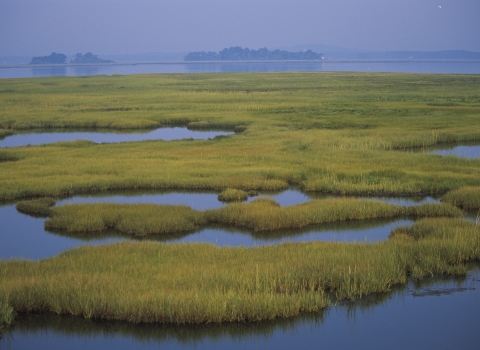There are many telltale signs of spring’s arrival. The snow starts to melt away. Flowers bravely poke through the soil. The sun extends its curfew past 5 o’clock. Warmth and growth return after the long winter months…and so do the birds!
From Virginia to Maine, and even up to Canada, migratory shorebirds are returning from their wintering grounds in the Bahamas and the southeastern United States, as they do every spring. Piping plovers, red knots, American oystercatchers, semipalmated sandpipers, sanderlings, and least terns are a few examples of the species you might see. Several of these birds are experiencing population declines, and a few are already listed as threatened and endangered.
Whether stopping during their long journey northward or staying for the season to breed, these feathery friends find irreplaceable nesting, feeding, and resting habitat on our Northeast beaches.
As the birds come back, here’s what to expect:
What’s going on behind that fencing?
The symbolic fencing you might see lining the mid to upper beach protects habitat for these migratory birds, specifically piping plovers, least terns, and common terns. Biologists and volunteers brave the icy ocean winds in March to rope off common nesting sites. The virtual barrier identifies breeding areas and discourages use by pedestrians, pets, and vehicles early in the season.
After their long, hard migration, the birds arrive to undisturbed habitat in April and May and can get right to nesting! Early-season breeding can lead to higher productivity for the birds and earlier removal of symbolic fencing from the beaches.
Some of those fence posts have signs on them…what’s going on with that?
Informational signs are an effective way for biologists to communicate with beachgoers about the birds. Even if you’re used to seeing the same signs year after year, it helps to have a quick refresher on what they mean. Most signs in areas where shorebirds are nesting or resting will read “Area Closed.” These are in place to keep people at a distance.
Shorebird eggs are well-camouflaged and so are tiny shorebird chicks, making it difficult for predators and pedestrians to see them. To avoid inadvertently stepping on nests or chicks, people need to stay outside the fencing.
Coming too close to nesting habitat can also stress out shorebirds. Incubating adults often try to lead potential predators away from their nests, which leaves eggs exposed to the elements for prolonged periods. High levels of disturbance can cause shorebirds to abandon their nests.
Other signs include “Pet Closure Area” and “No Driving.” These closures protect new hatchlings that can’t fly yet. Some chicks, like piping plovers, are no bigger than a cotton ball when they first hatch and blend in with the sand around them. It’s nearly impossible to see them from inside a vehicle, especially if they’re hidden behind ridges of sand in old tire tracks. They’re also hard to spot when feeding near the shoreline around piles of washed up seaweed and sea grasses called wrack.
Pet closures are enforced because both leashed and unleashed dogs can chase shorebirds and possibly catch and kill them. Even well-trained dogs pose a threat. These birds can’t distinguish between pets and natural predators, so dogs near nesting habitat can cause extreme stress for the birds.
Tips for sharing the shore:
1.Give the birds space! Keep your distance from fencing, and be aware of your surroundings.
2. Keep pets on leashes and out of “Pet Closure” areas.
3. Avoid flushing birds from the shore. They need their energy for breeding and refueling! If you see shorebirds eating or resting, try to avoid them.
4. Carry in, carry out. Make sure to take all your food waste and trash off the beach when you leave. Refuse attracts shorebird predators, like foxes.
5. Be careful with kites! Flying kites too close to shorebird nesting habitat can make the birds think there is a predator overhead, like an American crow or kestrel, and cause unnecessary stress.
6. Pack your binoculars in your beach bag this summer! You can observe and appreciate these beautiful birds from afar. The Northeast has some amazing wildlife, so while resting and relaxing on the sand this year, don’t miss out on the exciting nature right under your nose.
7. Know the local rules, regulations, and notices about pets, driving, fireworks, and other activities before you visit the beach. Your local beaches should have online information through town, state, or federal websites, with information specific to your area. Always err on the side of caution and contact someone if you have questions. If you happen to see a biologist or steward on the beach monitoring these birds, ask them questions too!
After being cooped up all winter, it’s nice to imagine being out on the beach again. As you prepare to soak up the sun, keep these helpful tips in mind. Because, as much as we cherish the beaches of the Northeast, shorebirds depend on this limited habitat for their very survival.

